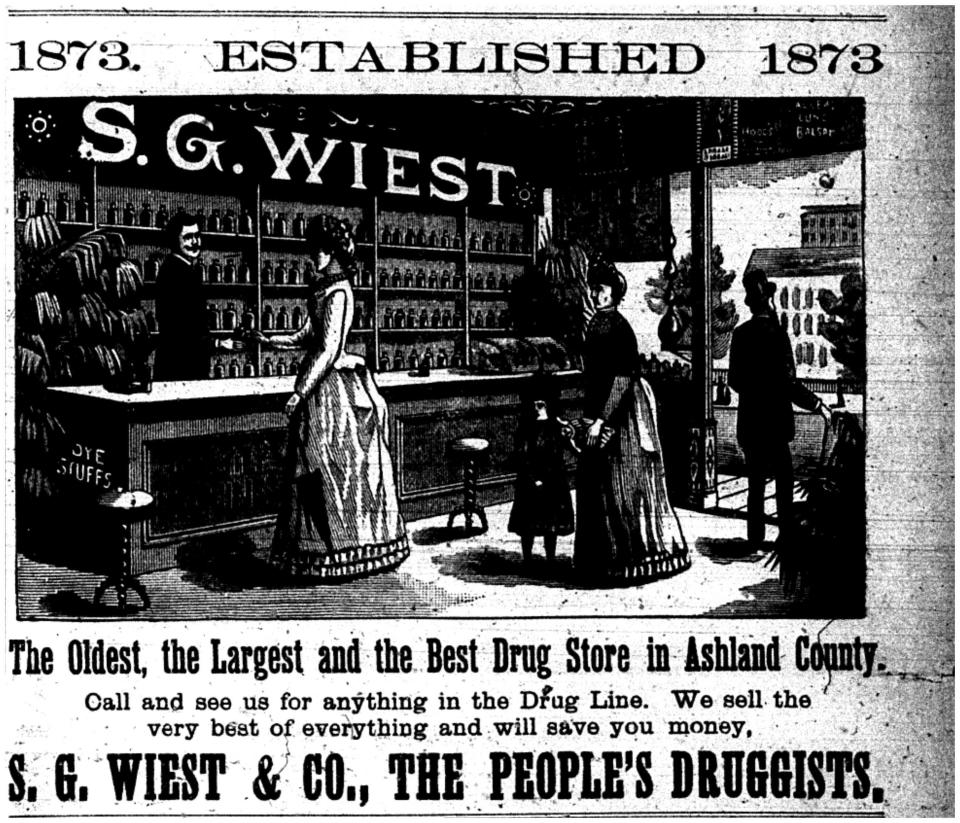Ashland Memories: Early druggists sold a plethora of products
The earliest mention of an Ashland druggist I have found is W.H.H. Potter in 1862. He dealt in “drugs, medicines, books, stationery, wall paper, etc.” on Main Street. He also was the telegraph operator and express agent.
Mr. Potter kept his drug store until 1867, which was when Dr. William K. Foltz arrived. He was a physician and druggist, and he set up shop next door to the old Miller House. This location is 26 W. Main, now owned by Ashland University.
Dr. Foltz sold drugs, paints, chemicals, varnishes, dye-stuffs, perfumes, and patent medicines. His store also carried “fancy goods” such as books, stationery, and wallpaper.
Foltz’s store burned in the great Main Street fire April 14, 1877, and he afterward sold out to Samuel Gates Wiest.

Pancoast family joins the pharmacy trade
Another early pharmacy was started in the late 1860s by Dr. Hezekiah B. Pancoast, who was joined in business by his son, Ohio Pancoast.
Ring’s Vegetable Ambrosia was a product available in 1868 at Pancoast and Son for $1 a bottle. It was a hair restorative, promised to return gray hair to its original hue, prevent dandruff and eradicate “humors” from the scalp, and even cause hair to grow again.
More: Ashland Memories: An early 20th century Rowsburg homecoming and playground dedication
Another item sold by the Pancoasts was De La Cours Oriental cream. This ladies toilet essential held the secret to “make yourself agreeable.” It was good for the complexion and smelled nice too.
Dr. Pancoast died in 1876 and Ohio Pancoast died in 1887, but a third generation, Duff Pancoast, followed in his father’s and grandfather’s footsteps.
When Samuel G. Wiest arrived in Ashland in 1873, he learned the pharmacy trade as a clerk at J.P. Harley’s drug store before purchasing Dr. Foltz’s stock after the 1877 fire.

Wiest conducted business at Foltz’s old location until 1880. That year he sold out and took a break from the pharmacy, spending three years making cigars. J.W. Brant kept the pharmacy on that site, and it later came under the proprietorship of W.L. Rhoads.
When the Rhoads pharmacy closed in 1928, there had been a drug store at that location for 65 years. The City Loan took over the site, and the building that now stands there is engraved “The Ashland Bank and Savings Co.”
In 1883, Wiest announced his return to the drug business at a new location in the Masonic building, beside J. Brubaker’s dry goods store.
A tragedy unfolds inside Wiest's drug store
An 1883 ad in the Ashland Press noted Wiest’s store carried druggist’s sundries, including combs and brushes and mirrors, pocket books, perfumes and soaps, picture albums and frames, writing and tissue paper. He also carried whiskies, brandies, and wines, as well as Pittsburgh stock ale, “by the gallon.”
In 1892, a tragedy unfolded inside Wiest’s drug store. A physician determined to commit suicide, and having arranged the couch in his office, walked down to Wiest’s nearby drug store. There he took 15 grams of morphine, but the clerk caught him at it. Having admitted what he had done, the despondent doctor returned to his office, where his stomach was pumped, to no avail.
Wiest was remembered after his death in 1910 as being a “good dresser,” always keeping himself neat and clean. He also looked on the sunny side of life, always cordial and never complaining, a disposition that won him many friends.
This article originally appeared on Ashland Times Gazette: Ashland’s early druggists sold everything from paints to perfumes

